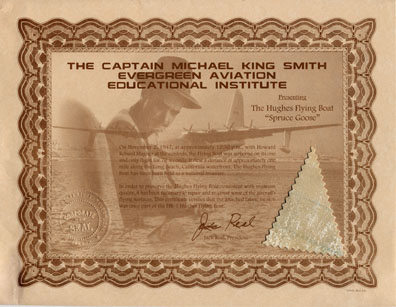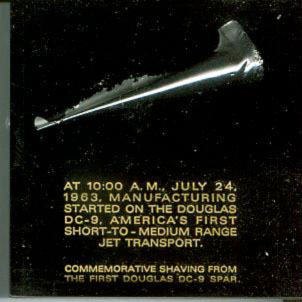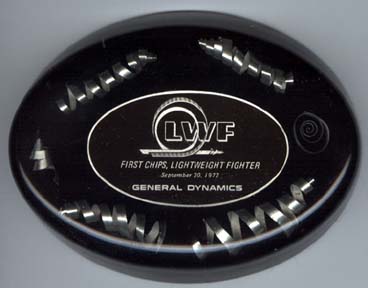

| | Check-Six Online Museum Air / Aviation / Aeronautical Wing 
Fabric Swatch from the "Spruce Goose" |
The "Spruce Goose" is a nickname commonly given to the Hughes H-4 Hercules, an aircraft designed and built by the Hughes Aircraft company, Howard Hughes' plane company. The nickname arose as a way of making light of the Hercules project due to Hughes' alleged misuse of government funding to build the aircraft. The Hercules is the largest flying boat, and has the largest wingspan of any aircraft ever built. Only one was built. Due to wartime restrictions on the availability of metals, the H-4 was built almost entirely of laminated birch, not spruce as its nickname suggests. The aircraft was a marvel in its time. It married a soon-to-be outdated technology — flying boats — to a massive airframe that required some truly ingenious engineering innovations. Hughes himself detested the nickname "Spruce Goose". On November 2, 1947 at approximately 12:30 pm, with Howard Hughes at the controls, the Flying Boat was airborne for 70 seconds and a distance of over a mile along the Long Beach, California, waterfront For many  years, the 'Spruce Goose' was contained in a sealed floating hangar by Howard Hughes. After his death in 1976, it was sold to the California Aero Club, who put it on display near the 'Queen Mary' ocean liner, and then resold it to the Disney company. In 1992, Disney 'evicted' the aircraft from its hangar, and it was given to the Evergreen Air Venture Museum in McMinnville, Oregon. years, the 'Spruce Goose' was contained in a sealed floating hangar by Howard Hughes. After his death in 1976, it was sold to the California Aero Club, who put it on display near the 'Queen Mary' ocean liner, and then resold it to the Disney company. In 1992, Disney 'evicted' the aircraft from its hangar, and it was given to the Evergreen Air Venture Museum in McMinnville, Oregon. In order to preserve the HK-1 consistent with museum quality, it was necessary to repair and re-cover some flying surfaces. This is to certify that the attached fabric is from Howard Hughes' HK-1 Flying Boat. | Lucite Paperweight with Metal from General Dynamics B-36J "Peacemaker" 52-2217A |
The B-36 Strategic Intercontinental Bomber was first conceived in 1941 as a transatlantic bomber to strike Europe from bases in the United States. Development of the bomber was initially delayed, and then ordered into production in 1943 for use against the Japanese home islands. However, the XB-36 prototypes first test flight wasn't until August 1946. The B-36 Peacemaker was the largest production aircraft ever built, with a wingspan of 230 feet. Powered by Six Pratt & Whitney R-4360-53 pusher-type radial engines, at 3,800 horsepower each; and four General Electric J-47-GE-19 turbojets, with 5,200 lbs. thrust each, it was known by pilots as the "Magnesium Monster". It reaped two other distinctions during it's career; it was the only U.S. bomber never to drop a bomb in war-time and the only aircraft capable of attacking a target on another continent and returning to home base without having to refuel. A B-36J crew consisted of a pilot, copilot, two navigators, bombardier, flight engineer, radio operator, radar operator, two Electronic Counter Measures operators and five gunners. pusher-type radial engines, at 3,800 horsepower each; and four General Electric J-47-GE-19 turbojets, with 5,200 lbs. thrust each, it was known by pilots as the "Magnesium Monster". It reaped two other distinctions during it's career; it was the only U.S. bomber never to drop a bomb in war-time and the only aircraft capable of attacking a target on another continent and returning to home base without having to refuel. A B-36J crew consisted of a pilot, copilot, two navigators, bombardier, flight engineer, radio operator, radar operator, two Electronic Counter Measures operators and five gunners. The B-36 on display at the Strategic Air Command Museum in Ashland, Nebraska, was manufactured by the Fort Worth Division of General Dynamics Corporation and delivered to the Strategic Air Command on December 22nd, 1953. In the course of routine restoration of the aircraft, it became necessary to remove a portion of the plane. The removed portion was divided in segments and set in lucite paperweight for sale to the general public. The paperweight is about 3 inches in diameter, is domed in shape, and made primarily of clear lucite. | First McDonnell Douglas DC-9 Production Shaving Paperweight |
The DC-9 was designed specifically to operate from short runways and on short- to medium-range routes so that the speed, comfort and reliability of jet transportation could be extended to hundreds of communities previously served only by propeller-driven airliners. 
| Place your pointer over the photo to see the reverse of the paperweight |
The Douglas Aircraft Company launched the DC-9 development project in April 1963, intending the DC-9 as a short-range companion to their larger four engine DC-8. Unlike the competing but slightly larger Boeing 727, which used as many Boeing 707 components as possible, the DC-9 was an all-new design, using two rear-mounted Pratt & Whitney JT8D turbojet engines, a small, highly efficient wing, and a 'T-tail'. In most configurations, DC-9 family aircraft have distinctive 5-abreast seating in coach class rather than the more common 6-abreast. Design, development and production of the DC-9 was centered in Long Beach, Calif., at what is now the Long Beach Division of Boeing Commercial Airplanes.
The DC-9 prototype flew February 25,1965 and entered service with Delta Air Lines in December of that year. It was an immediate commercial success, and 976 were built by Douglas who then merged with McDonnell in 1967. This paperweight contains, embedded in lucite, a commemorative shaving from the first Douglas DC-9 spar. It states on its front, "AT 10:00 A.M., JULY 24, 1963, MANUFACTURING STARTED ON THE DOUGLAS DC-9, AMERICA'S FIRST SHORT-TO-MEDIUM RANGE JET TRANSPORT." The reverse of the paperweight bears a sketch of a DC-9 in flight, and the company logo. | | | General Dynamics 'Light Weight Fighter' (YF-16) First Chips Paperweight |
The Light Weight Fighter (LWF) Program was a U.S. Air Force technology evaluation program initiated in the 1960's by a cabal of officers and defense analysts known as the "fighter mafia". It was spurred by then Major John Boyd's Energy-Maneuverability (E-M) theory of maneuverability, which indicated that excessive weight would have severely debilitating consequences on the maneuverability of an aircraft. The new aircraft was to be a light day fighter with a high thrust-to-weight ratio, a gross weight of less than 20,000 pounds (half that of its counterpart, the F-15), and high maneuverability. It resulted in the development of the YF-16 and YF-17; the latter would be adopted by the U.S. Navy as the F/A-18. Late in the program, in 1974, with the promise of European sales, the Air Force changed the program name to Air Combat Fighter (ACF), and committed to purchasing 650 models of the YF-16, adopted as the F-16.
 In May 1971 the US Congress released a report that was highly critical of both the F-14 and F-15 programs. They proposed funding the LWF with $50 million and an additional $12 million the next year. Five manufacturers submitted proposals - Boeing, General Dynamics, Lockheed, Northrop, and Vought, Ultimately, Secretary of the Air Force Robert Seamans chose to select the General Dynamics and Northrop entries to fund and build prototypes. In September of 1972, General Dyanmics began the manufacture of their prototype. In May 1971 the US Congress released a report that was highly critical of both the F-14 and F-15 programs. They proposed funding the LWF with $50 million and an additional $12 million the next year. Five manufacturers submitted proposals - Boeing, General Dynamics, Lockheed, Northrop, and Vought, Ultimately, Secretary of the Air Force Robert Seamans chose to select the General Dynamics and Northrop entries to fund and build prototypes. In September of 1972, General Dyanmics began the manufacture of their prototype.
The fly-off commenced in 1974 as both prototypes were delivered. Concurrently, Belgium, Denmark, Norway, and the Netherlands had formed the Multinational FIghter Program Group (MFPG) to select a replacement for their F-104s from among the Dassault Mirage F.1, YF-16, YF-17, and Saab JA37 Viggen. They indicated that the winner of the LWF contest would be the favored candidate. Up to this point, the LWF was merely an evaluation program with no plans to purchase models, but the possibility of a European order lead the Pentagon to reconsider. The Air Force was now seeking a multi-role fighter to replace the F-4 and F-105, so the program was renamed the Air Combat Fighter (ACF). In September 1974, the Air Force announced plans to purchase 650 ACF's. On 13 January, 1975, Secretary of the Air Force John McLucas announced the selection of the YF-16.
| First McDonnell Douglas MD-11 Production Chip Paperweight |
The '''McDonnell Douglas MD-11''' is a wide body aircraft powered by three engines. It is based on the DC-10, but featuring a stretched fuselage, more wingspan with winglets, refined aerofoils on the wing and tailplane sections, new engines, extensive use of  composites, and a two-crew, all-digital glass cockpit. Currently, most MD-11s are used in cargo operations; retired passenger versions of the MD-11, formerly used by airlines, are being converted into freighters. composites, and a two-crew, all-digital glass cockpit. Currently, most MD-11s are used in cargo operations; retired passenger versions of the MD-11, formerly used by airlines, are being converted into freighters. The MD-11 program was launched on December 30, 1986, with orders and commitments for 92 aircraft from 12 airlines and leasing companies. Part fabrication and milling started on March 4th, 1987, and the
assembly of the MD-11 began on March 9, 1988, with the first flight of an MD-11F (freighter version) on Jan. 10, 1990. Federal Aviation Administration certification was achieved on November 8, 1990. This paperweight is made from a 'CHIP FROM THE FIRST PART MILLED FOR THE MD-11 - MARCH 4, 1987 - TORRANCE, CALIFORNIA' the chip is enclosed in Perspex (Lucite) formed into a wedge shape. The whole paperweight measures about 3 inches by 3 inches by 2 inches. | First McDonnell Douglas C-17 Production Shaving Paperweight |
In the 1970s, US Air Force began looking for a replacement for the Lockheed C-130 Hercules tactical airlifter. To find a replacement, the Air Force held the Advanced Medium STOL Transport (AMST) competition, with Boeing proposing the Boeing YC-14, and McDonnell Douglas proposing the YC-15. However, the AMST competition was ultimately cancelled before a winner had been selected. Then, by the early-1980s, the USAF found itself with a very large, but aging fleet of C-141 Starlifters. Some of the C-141s had major structural problems as a result of heavy use. Compounding matters, USAF historically never possessed sufficient strategic airlift capabilities to fulfill its airlift requirements. In response, McDonnell Douglas elected to develop the YC-15 as the basis for a new aircraft. This aircraft, by then designated the C-17A Globemaster III, was ordered in August 1981. The new aircraft differed in having swept wings, increased size, and more powerful engines. This would allow it to perform all work performed by the C-141, but to also fulfill some of the duties of the C-5 Galaxy, so that the C-5 fleet would be freed up for larger, more outsize cargo. Development continued until December, 1985 when a full-scale production contract was signed. Its maiden flight was on September 15, 1991 from the McDonnell-Douglas west coast plant in Long Beach, California. This aircraft (T-1) and five more production models (P1-P5) participated in extensive flight testing and evaluation at Edwards AFB. Soon after the C-17 reached production, McDonnell Douglas was acquired by its former competitor, Boeing. This paperweight is made from lucite, contains a milling fro metal, and a card stating 'SHAVING FROM THE FIRST PART MILLED FOR THE C-17 - 2 November 1987'. The lucite is formed into a wedge shape. The whole paperweight measures about 3 inches by 3 inches by 2 inches. |
On to the next corridor of the "Air Wing" of the "Check-Six Online Museum"...                          
|
